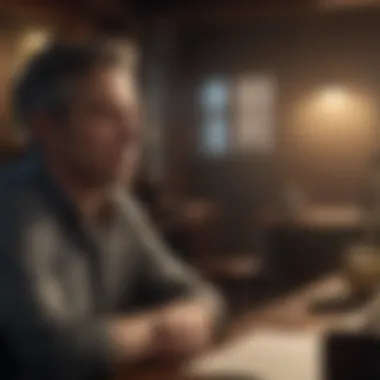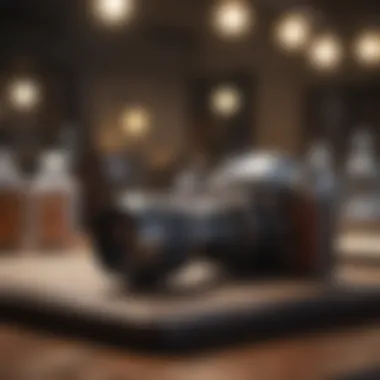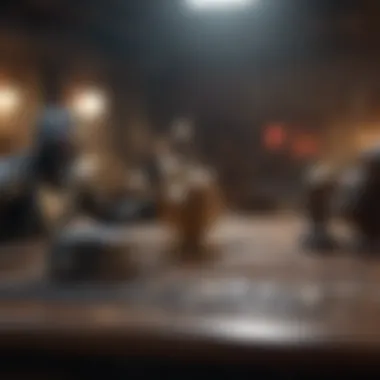Navigating Copyright: Safeguarding Your Creative Work


Intro
In this digital age, creators are blossoming like wildflowers. Yet, with the surge of creativity comes the crucial task of protecting one's intellectual property. Copyright isn’t just some legal jargon tossed at you in law school; it’s the backbone of how creatives secure their hard work. Whether you're an artist, writer, designer, or musician, understanding copyright can mean the difference between thriving or losing your hard-earned creations to the wolves of the internet.
Joining the fray of countless creators means you might face an uphill battle to truly understand your rights. But fret not, navigational compasses exist within the labyrinth of copyright laws.
This article digs deeper into topics such as the fundamental concepts of copyright law and which steps are necessary to secure the protection your work deserves. From the intricacies of copyright registration to strategizing the best methods to shield your creations, we leave no stone unturned.
Why does this matter? For one, it equips you with the knowledge needed to safeguard your original works against infringement, ensuring that your creations become a source of joy and income rather than a legal quagmire.
Let’s roll up our sleeves and get down to business, because when it comes to protecting your creative work, knowledge is your greatest ally.
Understanding Copyright
Copyright is often seen as the backbone of creative expression, safeguarding individual artistry while fostering a thriving marketplace for ideas. In this light, understanding copyright is essential for anyone wishing to protect their intellectual property. This section delves into fundamental details that shape what copyright is, its scope, and its implications for various types of works. As creative individuals navigate today's landscape, grasping these concepts isn't just beneficial; it’s vital.
Definition and Scope
Copyright refers to the legal right granted to the creator of an original work, allowing them to control the use of their creation. This right means that the creator can reproduce, distribute, perform, or display their work exclusively for a specific period. It applies automatically upon creation; once a work is fixed in a tangible medium—be it written down, recorded, or otherwise—copyright springs into existence without the need for formal registration.
The scope of copyright, however, is nuanced. While most artistic endeavors qualify for protection, there are some exceptions. For instance, ideas, methods, or systems themselves cannot be copyrighted, only the expression of those ideas can be. This creates a vital distinction in understanding how one can safeguard their creativity without infringing on the rights of others.
Types of Works Protected
Copyright encompasses a wide array of creations, each with its own characteristics and nuances. Here are some key types worth noting:
Literary Works
Literary works form a cornerstone of copyright protection. This category includes novels, poems, essays, and even blog posts. A defining feature of literary works is their ability to express complex thoughts and ideas through language. The creativity embedded in storytelling, character development, and narrative structure makes literary works a popular choice for protecting original content. However, one must navigate the intricacies of creative writing to avoid accidental similarities to other works, as plagiarism is a significant pitfall.
Musical Works
The world of musical works not only encompasses written compositions but also the associated recordings. The melodic structures, lyrics, and harmonies created by musicians fall under copyright. The key characteristic of musical works lies in their uniqueness and emotional resonance. For artists, protecting their music is extremely important, given its commercial potential in today's streaming era. But, navigating the fine line between inspiration and infringement is crucial, as many classic elements can be easily replicated.
Artistic Works
Artistic works represent expressions of creativity that extend beyond traditional definitions. This category includes paintings, sculptures, photographs, and even modern digital art. A significant aspect of artistic works is their visual appeal and the ability to communicate emotion and narrative without words. Artists benefit significantly from copyright, enabling them to control how their art travels through galleries, online platforms, and various media. Nonetheless, the realm of artistic interpretation can sometimes lead to disputes over originality.
Software and Technology
In our tech-driven world, software and technological creations receive copyright protection as well. This includes source code, application designs, and even the algorithms powering various platforms. The distinguishing feature is the functionality tied to creativity, where a piece of software not only performs tasks but also incorporates original design principles. With the rapid evolution in technology, understanding copyright in software can be complex but is necessary for developers wishing to protect their innovations.
Duration of Copyright Protection
The duration of copyright protection varies by jurisdiction, but generally, it lasts for the life of the author plus additional years—often extending to 70 years after the creator's death. For works created in a corporate setting or by multiple authors, the rules can differ. Understanding the timeline is crucial as it dictates how long rights are maintained and when works can enter the public domain, allowing others to use them freely without legal ramifications.
"Copyright isn’t just about protecting your work; it’s a fundamental tool to ensure creators are compensated fairly."
By grasping these core concepts, individuals can not only shield their creative expressions but also navigate the complexities associated with copyright in a rapidly changing digital environment. This foundational knowledge paves the way for deeper understanding of the nuances involved in securing rights.
Why Copyright Your Work?
In today’s fast-paced creative landscape, securing one’s rights through copyright is not just a matter of legal formality; it’s a crucial element in ensuring the longevity and integrity of your creations. As a young artist or an aspiring writer, you might wonder why you should invest time and resources into copyrighting your work. The answer hinges on understanding the many benefits and the protective barriers that copyright law can provide to creative individuals.
Securing Your Rights
When you copyright your work, you establish legal ownership over your creation, which is paramount in a world where ideas can be copied with a single click. Without copyright, anyone could freely use or alter your original work without your permission, which could lead to misunderstandings and potential financial losses. That’s why copyrighting your work is a powerful way to secure your rights, allowing you to determine how others may use your creation. This sense of control doesn't just offer peace of mind; it actively fosters a healthier creative environment where innovation can thrive.
"Copyright is not just a legal necessity; it's your first line of defense against exploitation."
It’s essential to recognize that copyright is more than just a piece of paper. It’s almost like a form of insurance. It protects your interests and helps you defend against unauthorized use of your work. Securing those rights can be particularly beneficial if you are planning to distribute or sell your work. When the world knows what’s yours, you’ll have a leg to stand on should anyone decide to take the shortcut route with your content.
Legal Remedies Against Infringement
Despite taking precautions, infringements can still occur. This is where the legal remedies that come with copyright protection become valuable. If someone uses your work without permission, you have the right to take action. The law allows you to issue cease and desist letters, backing you when someone doesn’t respect your copyright.
But what if this initial step doesn’t resolve the issue? In that case, you’re looking at your legal options. Depending on the situation, you may take your case to court, where you'll be able to pursue damages. Knowing you have these options at your disposal provides an added layer of security. It’s a way of letting potential infringers know that you are vigilant and willing to protect your creative output.


Enhancing Market Value
Another underappreciated benefit of copyrighting your work is the enhancement of its market value. A copyrighted work isn't just a piece of art or a manuscript; it's a valuable asset. Potential buyers or collaborators often view copyright as a definite sign of professionalism and diligence, which can mean the difference between a lukewarm response and a lucrative offer.
When you present your work with clear copyright protections, it tells investors, clients, or publishers that you take your craft seriously and that your creative content is an investment worth preserving. Often, this perceived value reflects not only the quality of the work but also the spirit of the creator behind it. In essence, copyright can lend an additional layer of credibility and trust to your endeavors.
The Process of Copyright Registration
The art of registering copyright is not just about filling out forms. It’s a necessary step for creators who want to protect their original works effectively. By understanding the ins and outs of this process, you secure your creative ideas, ensuring they don’t get misused. The essence of the registration process is making it clear that your work is yours, providing you with legal backing and peace of mind.
Step-by-Step Guide to Registration
Gathering Required Materials
Before even thinking about pressing that submit button, it's crucial to gather everything you’ll need. This might sound mundane, but it’s absolutely essential. The main documents typically required include a copy of the work you want to copyright, a filled-out application form, and other identification materials.
The key characteristic of this step is preparation. It sets the foundation for your application moving forward. Not having the required materials can lead to delays or, worse, rejection of your application. Some may find gathering this stuff tedious, but it’s a beneficial choice for creators who want to ensure they cross every ‘t’ and dot every ‘i’.
A unique feature of gathering materials is the emphasis on evidence of creation. This may serve you in the unfortunate event of any legal disputes. When everything is gathered neatly, it makes the next steps a lot smoother.
Filling Out the Application
Next comes filling out the application, which is quite critical. This step requires attention to detail; you must provide accurate information about your work and yourself. This is your chance to articulate exactly what you’re protecting.
The key characteristic here is accuracy. Errors or omissions can lead to your application being delayed or rejected. The digital platforms and online forms make it a fairly straightforward procedure. If you wish to protect the integrity of your work, investing time in this step is certainly worth it. The unique feature of this step lies in the ability to explain your work’s relevance and originality concisely. This can influence how your work is seen, both in terms of artistry and legality.
Paying Fees
Lastly, there’s the matter of fees. While it might seem like an unnecessary burden, this is part and parcel of the registration process. Usually, it requires a modest fee that varies based on whether you're registering online or through traditional means.
The advantage of paying fees is that it formalizes your application. Your work doesn’t just remain an idea; it’s now legally recognized. It’s a small price to pay for protection that can save you a mountain of headaches later on. However, a downside could be the pressure it adds, especially for new creators. Recollecting funds and allocating a budget for this eventuality should be part of your plan.
Where to Register
National Copyright Office
Now that the application is filled out and fees are ready, the next step involves deciding where to submit your application. The National Copyright Office is the primary location for copyright registration in many countries. This institution provides a centralized place for recording copyrights, ensuring they are recognized legally.
A significant characteristic of the National Copyright Office is its reliability. It’s where all official records reside. Trusting this office can protect your work legally against infringement. You get to leverage decades of established protocols and regulations.
However, the downside for some may be the slower processing times compared to online portals. The lack of immediacy can feel daunting for creators eager to see their work protected.
Online Registration Portals
On the flip side, online registration portals have revolutionized the process, making it faster and more accessible. Many creators prefer online registration because it allows them to submit applications from anywhere with internet access, at any time.
The key feature that makes this option so popular is speed. Many platforms process applications much quicker than traditional offices. However, this can sometimes lead to a sense of informality, as some creators worry that online submissions might lack the same semblance of security compared to official offices.
In summary, navigating the copyright registration process involves careful steps: gathering your materials, filling out the application accurately, paying the requisite fees, and choosing where to register your work. Each step plays an intricate role in protecting your creative expression and is worth the effort to ensure that your intellectual property remains safeguarded.
Difference Between Copyright Ownership and Copyright Registration
Copyright ownership and copyright registration are two key aspects that artists, writers, and creators must navigate. It’s crucial to understand how these concepts interplay to ensure that original works are effectively safeguarded. While copyright ownership relates to who holds the rights to a work, registration involves officially recording these rights with a governing body. These distinctions are significant, as they affect how creators can enforce their rights and engage in legal actions if necessary.
Ownership Explained
Initial Ownership Rights
When you create something original, be it a painting, a novel, or a piece of software, you automatically hold initial ownership rights over that work. This fundamental right is important as it affirms your authority as the creator. It’s a legal acknowledgment that you are the first and primary owner of the work. This straightforward characteristic of initial ownership rights makes it a beneficial feature for every creator. The big upside here is that you don’t have to jump through hoops to protect your creation initially; it’s yours by virtue of creation.
However, despite the clarity around these initial rights, there are unique challenges. For instance, proving ownership later can become a tad tricky without registration. As they say, “the proof is in the pudding.” It’s essential to keep records of your creative process, so if disputes arise, you have evidence to back your claim.
Joint Copyrights
In many cases, creative projects are collaborative efforts. Think of a band or a co-authored book; here is where joint copyrights come into play. Joint copyrights arise when two or more individuals contribute to a single work. The significant characteristic of joint copyrights is that each party holds an equal share of ownership rights. This means all contributors have a say in how the work is used or modified, which can be a popular arrangement in creative fields such as music or publishing.
Yet, this structure can also lead to complications. For example, without clear agreements in the beginning regarding how profits and decisions will be handled, disputes may arise amongst creators down the line. The unique aspect of joint copyrights is the collective model of ownership, which encourages collaboration but also necessitates strong communication and understanding among participants.
Benefits of Registration


When we talk about the benefits of copyright registration, the advantages are multiple. Registration transforms initial ownership into a more enforceable right, establishing a public record of your claim. This can be particularly advantageous if someone else tries to use your work without permission.
- Legal Advantages: Should you end up in a legal tussle, registered works often receive more protection under the law.
- Financial Considerations: Sometimes, having a registration can boost your marketability, potentially allowing creators to attract investors or buyers more easily.
- Statutory Damages: If you opt for registration, you may qualify for statutory damages in cases of infringement, which can be much higher than what you would receive otherwise.
In a nutshell, while ownership grants you immediate and automatic rights over your work, registration offers you a suite of additional protections and legal advantages that safeguard your creative expression in the long run. As the landscape of copyright continues to evolve, understanding these distinctions will help you navigate the risks effectively.
Monitoring and Enforcing Your Copyright
Protecting your creative work goes beyond merely obtaining a copyright. It's about actively watching over your rights and making sure they aren't breached. Monitoring and enforcing copyright is crucial for anyone serious about safeguarding their intellectual property. It helps creators maintain control of their work and shields them from unauthorized use that can dilute their brand, undermine their earnings, and impact their reputation.
In an increasingly digital world, where each mouse click can potentially bring your work in front of thousands, the need for vigilance can't be overstated. It's not just about crafting something original but also ensuring it isn’t taken for a ride.
Strategies for Monitoring
To effectively enforce your copyright, one needs a plan. Here are several strategies that can assist you in monitoring your creative work:
- Utilizing Online Tools: There are various platforms that can monitor the web for potential infringements. Services like Google Alerts can notify you if your work gets mentioned online.
- Setting Up Copyright Watches: Some companies offer continuous monitoring services to keep an eye on various platforms for unauthorized use of your work. This could be an invaluable support to your enforcement endeavors.
- Social Media Surveillance: Platforms like Facebook and Instagram have their own mechanisms for reporting copyright infringement. Regularly checking these sites for misuse is a prudent step.
- Networking with Other Creators: Joining forums or communities tailored to your creative field can give you insights into common infringement tactics and share leads on violators.
By employing these strategies, creators can establish a proactive approach to copyright management. But monitoring isn't enough; one must also take action against those who infringe.
Taking Action Against Infringers
Once you identify a potential infringement, it's essential to act. Two primary methods typically come into play: sending cease and desist letters, or, if necessary, moving forward with legal proceedings.
Cease and Desist Letters
A cease and desist letter is the first line of defense when addressing unauthorized use of your work. This formal communication notifies the infringer of the breach and urges them to stop using your work immediately. It's often seen as a less confrontational approach that can resolve disputes without escalating into legal conflict. One key characteristic of cease and desist letters is that they’re usually sent before any legal action, serving as a warning sign to the infringer.
They can be beneficial because:
- Cost-Effective: Compared to legal proceedings, drafting a letter is less expensive.
- Potentially Quick Resolution: Many infringers may not realize they’re violating your rights and could cease their actions once aware.
However, there are some downsides. Not all infringers will respond favorably to such letters, and some may ignore the communication, necessitating further action. Additionally, improperly drafted cease and desist letters can be ineffective, or worse, could open you to liability.
Legal Proceedings
If cease and desist letters fall flat, pursuing legal action could be your next step. Legal proceedings help reinforce your rights and assert your ownership over your creative work. They serve as a powerful tool against infringers, especially those who have blatantly disregarded your requests.
Legal proceedings can be beneficial because:
- Enforcement of Rights: They provide a clear legal framework to demonstrate and enforce your copyright.
- Potential Compensation: If successful, you could potentially recover damages incurred due to the infringement.
On the flip side, they also have notable disadvantages. The process can be lengthy, costly, and not guaranteed to yield a favorable outcome. Furthermore, it may strain relationships within your professional network, especially if the infringer is someone you know.
Copyright Exceptions and Limitations
Understanding copyright exceptions and limitations is essential for both creators and consumers. These concepts grant a set of rights that serve as a buffer between exclusive copyright protections and the public’s access to various forms of creativity. They are vital to maintaining a balanced landscape, where artists can protect their work while still allowing others to engage with it under certain conditions. Let's delve into two critical aspects of this topic: the Fair Use Doctrine and Public Domain considerations.
Fair Use Doctrine
The Fair Use Doctrine is one of the most discussed and frequently misunderstood aspects of copyright law. Essentially, it permits the limited use of copyrighted material without obtaining permission from the rights holder. This is significant for creators, educators, and the general public because it provides a legal framework for discussing, critiquing, or building upon existing works.
What qualifies as fair use? There are four main factors to consider:
- Purpose and character of the use: Is it commercial or for nonprofit educational purposes? Uses that transform the original work, such as satire or criticism, tend to favor fair use.
- Nature of the copyrighted work: Using factual works is often seen as more favorable than using creative ones.
- Amount and substantiality: How much of the work is being used? Small portions usually bolster a fair use claim, but using a significant part of the work may not.
- Effect on the market: Does the new work impede the market for the original? If the use could substitute for the original, it’s less likely to be considered fair use.
Navigating these guidelines can be tricky, and often it requires case-by-case analysis. A safer bet is that if your use does not detrimentally affect the market value of the original work, it stands a better chance of falling under the auspices of fair use.
“Fair use is a powerful tool in a creator’s arsenal, but its complexity makes it essential for artists to understand the intricacies of their specific situations.”
Public Domain Considerations
Public domain refers to creative works that are not protected by copyright and can be freely used by anyone. Works fall into public domain typically due to one of the following reasons:
- The copyright has expired.
- The creator intentionally placed the work in the public domain.
- The work is not eligible for copyright protection.
Understanding public domain is crucial for both creators and users, as it enlarges the pool of resources available for inspiration, adaptation, and education. For instance, classic literature, ancient texts, and many early films are in the public domain. Creators can leverage these works without worrying about copyright infringement, allowing for a richer tapestry of cultural expression.


Additionally, knowing what works are in the public domain can enhance a creator’s portfolio. For those seeking inspiration, accessing these texts can spur new ideas or lead to innovative reinterpretations.
In short, copyright exceptions like the Fair Use Doctrine and the concept of Public Domain play pivotal roles in shaping attitudes towards creativity and ownership. By understanding these frameworks, creators can navigate their legal landscape more effectively, ensuring they don’t inadvertently overstep while still finding avenues to engage with existing works.
International Copyright Considerations
In a world that has become increasingly interconnected, understanding international copyright considerations is paramount for creators who seek to protect their work beyond their home country. The digital age has blurred borders, making it easier to share creative endeavors globally. However, this cross-border sharing raises complex legal questions regarding ownership and protection, making international copyright treaties and local laws essential topics for any serious creative.
Understanding International Treaties
Berne Convention
The Berne Convention is a pivotal agreement in the realm of international copyright law. Established in 1886, it was crafted to ensure that creators are afforded rights in other member countries, which totals to over 170 today. One of the convention's key characteristics is the principle of "automatic protection" – once a work is created, it doesn’t need to be formally registered to receive protection among member states. This makes it a beneficial choice for creators since it simplifies the process of obtaining copyright in multiple jurisdictions.
A unique aspect of the Berne Convention lies in its minimum standards for copyright protection. This means that each member state is required to provide at least the same level of protection that is offered in the originating country. However, some might argue that this also leads to discrepancies, as different countries interpret and implement these standards in varied ways, which can be a source of confusion.
TRIPS Agreement
The TRIPS Agreement – Trade-Related Aspects of Intellectual Property Rights – came into effect in 1995 as part of the World Trade Organization framework. The TRIPS Agreement harmonizes the rules regarding copyright and other intellectual property rights across member countries. Its key characteristic is that it elevates the level of protection required to comply with its provisions, which consequently benefits creators by providing a uniform standard across borders.
A unique feature of the TRIPS Agreement is its enforcement mechanism. It obligates signatories to enact laws that allow for effective enforcement against copyright infringement, thus protecting creative works on a global scale. Though, some critics regard its strict enforcement mandates as a double-edged sword, emphasizing that it can place burdens on developing nations that may struggle to comply with these heightened requirements.
Navigating Territorial Rights
Navigating territorial rights can be particularly tricky when your work crosses international boundaries. Copyright does not automatically offer global protection; instead, it is governed by the laws of individual countries. Therefore, a creator must be aware of the copyright regulations in every jurisdiction where their work may be used or distributed.
Here are some important points to consider:
- Local Laws Matter: Each country has its own copyright laws, which may differ from the laws in your home country.
- National Treatment Principle: Under treaties like the Berne Convention, foreign creators must be treated as if they were locals within the member countries. However, certain exceptions may exist.
- Licensing: If a creator wishes to distribute their work in multiple countries, securing the appropriate licenses may be essential.
By understanding the intricate landscape of international copyright, creators can make informed decisions and take proactive steps to safeguard their creative expressions across various territories.
Digital Age and Copyright
In today’s fast-paced digital environment, the intersection of technology and copyright law presents unique challenges and opportunities. As creators leverage online platforms to share their work, they must navigate a landscape that's constantly shifting under the influence of innovation. Understanding the implications of copyright in the digital age is critical for safeguarding creative output.
Impact of Technology
The rise of the internet and digital tools has transformed how we create, distribute, and consume content. While technology makes it easier to share work widely, it also increases the risk of infringement. For example, someone can quickly download, copy, or modify a piece of art or software without the creator's permission. This ease of access complicates the enforcement of copyright.
Moreover, new technologies like blockchain are emerging as potential solutions for tracking ownership and usage rights. These decentralized ledgers could offer a more secure way for artists and creators to maintain control over their original works. Still, the legal frameworks governing such technologies remain in development, which raises questions about their reliability and effectiveness. The growing reliance on digital formats also means that creators must understand various file types and usage rights in different media, keeping them constantly on their toes.
Copyright in Social Media
Social media platforms have become a double-edged sword for content creators. On one hand, these sites offer unparalleled exposure and audience engagement. On the other hand, they come with a host of copyright concerns that can catch the unwary off guard. Posts go viral at lightning speed, and it's often difficult to attribute the original creator when the work is shared extensively.
"The lines between sharing and infringement are often blurred on social media, making it crucial to establish clear guidelines for your own work."
To manage this effectively, creators should consider employing watermarking techniques or using copyright notices to clearly assert their ownership. Knowing how to navigate platform-specific policies around copyright is just as essential. For instance, platforms like Facebook and Instagram have their own rules regarding user-generated content, which can affect how creators protect their rights.
In summary, the digital age presents both risks and opportunities regarding copyright. By understanding these elements, creators can better protect their work while still leveraging technology to reach broader audiences. With proactive measures, they can secure their creative legacy in an ever-evolving digital world.
The End: Protecting Your Creative Expression
In this comprehensive examination of copyright, it’s critical to recognize the significance of actively protecting your creative expressions. It’s not just about claiming authorship or ownership; it’s about ensuring that the fruits of your labor are safeguarded against unauthorized use. For creatives and professionals, copyright represents a legal weapon in the ever-competitive arena of intellectual property, allowing one to navigate the complex landscape of rights and infringement.
The Ubiquity of Creative Works
In a world brimming with creativity, the evolution of digital platforms has made it easier than ever for works to be disseminated and shared. However, this increase in accessibility has also given rise to unprecedented challenges. Without the proper protections in place, artists, writers, and innovators could find their hard work exploited without consent. Therefore, taking the necessary steps to register and enforce your copyright is not simply recommended, it’s essential.
"The strongest copyright is that which is enforced with clarity and diligence."
Benefits of Securing Copyright
By securing your copyright, several benefits ensue that can bolster your career:
- Ownership Recognition: A registered copyright clearly marks your ownership, helping others understand the scope of your rights.
- Legal Redress: Infringements can lead to serious consequences; without registration, you might find yourself cornered if someone leverages your work without permission.
- Market Advantage: A strong copyright portfolio can enhance the value and marketability of your work, showcasing your commitment to originality and intellectual property.
Considerations for Creative Protection
Understanding copyright’s nuances is necessary for anyone looking to protect their creative work. Awareness of copyright doctrines, like fair use, and how they might impact your creations is crucial. Moreover, for those venturing into the international stage, constructing a comprehensive strategy that considers global treaties and territorial rights is paramount.
Moreover, as the landscape changes, remaining vigilant against copyright infringement is an ongoing commitment that should not be taken lightly. Remember, ignorance of the law is no excuse, and proactive measures can prevent potential headaches down the line.
Ultimately, protecting your creative expression is a multifaceted endeavor. By thoroughly navigating the layers of copyright, you ensure that your unique contributions to the world are respected, recognized, and rewarded. In this digital age, where everything is ripe for sharing, taking control of your creative legacy is not only wise, but a crucial step in a successful creative career.



